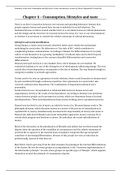Samenvatting
Chapter 4 - Summary of the book Consumption and lifestyles a short introduction
- Instelling
- Wageningen University (WUR)
Summary of chapter 3 of the book Consumption and lifestyles a short introduction, written by Dieter Bögenhold and Farah Naz. This is literature for the course lifestyles and consumption (CHL20806) at Wageningen University.
[Meer zien]





